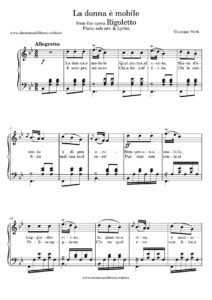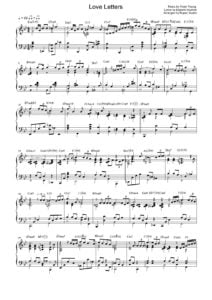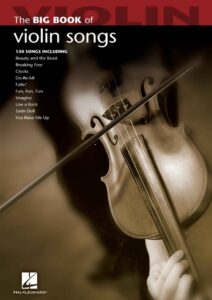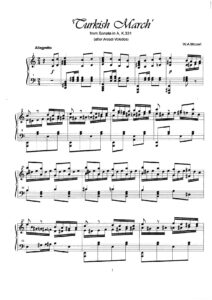Browse in the Library:
| Artist or Composer / Score name | Cover | List of Contents |
|---|---|---|
| Verdi – Libiamo Ne Lieti Calici (La Traviata) (Musescore File).mscz | ||
| Verdi – Va pensiero Piano Solo arr. NABUCCO ACTE III Choeur des ésclaves hébreux.mscz | ||
| Verdi La dona e mobile Rigoletto Piano Solo with lyrics |
 |
|
| Verdi La Dona E Mobile Rigoletto Piano Solo With Lyrics Musescore File.mscz | ||
| Verdi Requiem Cambridge Music Handbooks (Book) |
 |
|
| Vernon Duke Autumn In New York |
 |
|
| Vernon Duke – Autumn In New York (guitar arr. with TABs) |
 |
|
| Vertical Horizon – Best I Ever Had | ||
| Via con me (Paolo Conte) | ||
| Via del Campo (Fabrizio De Andrè) | ||
| Vianne Sets Up Shop (Chocolat OST) Rachel Portman | ||
| Vicente Amigo Ciudad De Las Ideas (Guitar TAB) |
 |
|
| Victor Herbert’s masterpiece Ah Sweet Mystery Of Life |
 |
|
| Victor Jara Un Canto Truncado Joan Jara (Book) Español – Spanish Biography – Biografía |
 |
|
| Victor Labenske Piano Miniatures 24 Short Solos In All Major And Minor Keys (Intermediate Piano) |
 |
Victor Labenske Piano Miniatures 24 Short Solos In All Major And Minor Keys (Intermediate Piano) |
| Victor Wooten Best of – transcribed by Victor Wooten Guitar Tabs |
 |
Victor Wooten Best of – transcribed by Victor Wooten Guitar Tabs |
| Victor Young When I Fall In Love |
 |
|
| Victor Young – Blue Star The Medic Theme |
 |
|
| Victor Young – Stella By Starlight Jazz Standard |
 |
|
| Victor Young – When I Fall In Love |
 |
|
| Victor young – When I Fall In Love Sheet Music as recorded by Celine Dion and Clive Griffin (fromm Sleepless in Seate) |
 |
|
| Victor Young (Bill Evans) – When I Fall In Love (Musescore File).mscz | ||
| Victor Young And Peggy Lee Johnny Guitar |
 |
|
| Victor Young Around the World (piano solo sheet music) | Victor Young Around the World (piano solo sheet music) | |
| Victor Young Around The World In 80 Days Easy Piano Solo |
 |
|
| Victor Young Love Letters (Piano Solo arr.) |
 |
|
| Victor Young Stella by Starlight | Stella-By-Starlight-Victor-Young | |
| Victor Young Stella By Starlight Easy Piano Solo |
 |
|
| Victor Young Stella By Starlight Victor Young & Ned Washington Sheet Music 1946 Jazz Standard (Vintage sheet music) |
 |
|
| Vida Y Arte De Glenn Gould – by Bazzana Kevin (Español Spanish) |
 |
|
| Viktor Semenuita Suite The Spring Awakening for Guitar quartet |
 |
|
| Villa-Lobos – 12 Guitar Etudes (Doze Estudios para Violao) |
 |
|
| Villa-Lobos – Bachiana Brasileira no. 4 | ||
| Villa-Lobos – Bachianas Brasileiras No. 5 – Aria (Cantilena) partitura |
 |
|
| Villa-Lobos – Choros (N°1) Guitar Sheet Music (Musescore File).mscz | ||
| Villa-Lobos – Prelude N° 3 (Musescore File).mscz | ||
| Villa-Lobos -Etude №1 (Musescore File).mscz | ||
| Villa-Lobos A Lenda do Caboclo | Villa-Lobos Lenda do Caboclo | |
| Villa-Lobos Five Preludes for Guitar, W419 |
 |
Wes Montgomery The Early Years (Mel Bay) Jazz Guitar Solos Tablature |
| Villa-Lobos Guia Patrico Album 2 | Villa-Lobos-GP-Album-2 | |
| Villa-Lobos Guia Patrico Album 3 | Villa-Lobos Guia Patrico Album 3 | |
| Villa-Lobos Prelude 1 for Guitar | Villa-Lobos prelude 1 | |
| Villa-Lobos Prelude No 1 (Musescore File).mscz | ||
| Villa-Lobos Tristorosa Guitar arr. by Gorbunov |
 |
|
| Villa-Lobos, Heitor – Obras Completas (complete works for GUITAR) |
 |
Villa-Lobos obra completa guitarra |
| Villa-Lobos, Heitor – Aria (Cantilena) arr. for voice and guitar | Villa-Lobos, Heitor – Aria (Cantilena) arr. for voice and guitar | |
| Villa-Lobos, Heitor – Bachianas Brasileiras No 4 No 2 – Choral Song Of The Jungle | ||
| Villa-Lobos, Heitor – Saudades das selvas brasileras (pour piano) | Villa-Lobos – Saudades das selvas brasileras | |
| Vince Guaraldi A Charlie Brown Christmas |
 |
Vince Guaraldi A Charlie Brown Christmas |
| Vince Guaraldi Christmas Time Is Here |
 |
|
| Vince Guaraldi Linus And Lucy (Piano Solo) Peanuts Theme | Vince Guaraldi Linus And Lucy (Piano Solo) Peanuts Theme | |
| Vince Guaraldi – Cast Your Fate To The Wind | Vince Guaraldi – Cast Your Fate To The Wind | |
| Vince Guaraldi – Linus And Lucy (Piano Solo) Peanuts Theme (Musescore File).mscz | ||
| Vince Guaraldi A Charlie Brown Christmas For Solo Jazz Guitar with TAB |
 |
Vince Guaraldi A Charlie Brown Christmas For Solo Jazz Guitar with TAB |
| Vince Guaraldi A Charlie Brown Christmast Beginning Piano Solos |
 |
Vince Guaraldi A Charlie Brown Christmast Beginning Piano Solos |
| Vince Guaraldi Collection 9 transcriptions |
 |
Vince Guaraldi Collection 9 transcriptions |
| Vince Guaraldi The Christmas Song |
 |
|
| Vince Guaraldi The Christmas Song (Mel Tormé and Robert Wells) Piano Solo | Vince Guaraldi The Christmas Song (Mel Tormé and Robert Wells) Piano Solo | |
| Vineyard Songbook (2011) Guitar Songchords |
 |
Vineyard Songbook (2011) Guitar Songchords |
| Vinicius De Moraes Vols 1,2 & 3 Guitar |
 |
Vinicius de Moraes 1,2 & 3 books |
| Vinnie Moore Masterclass (audio Mp3 Tab And Backing Track) GUITAR TABS and Al Di Meola Reh Video Booklet |
 |
|
| Violin Songs Big Book Of (Songbook) 130 songs |
 |
Violin Songs Big Book Of (Songbook) 130 songs |
| Virtuosity And The Musical Work The Transcendental Studies Of Liszt By Jim Samson Book |
 |
|
| Vittorio Monti Czardas (Piano Solo arr.) |
 |
|
| Vittorio Monti Czardas Piano violin arr. by J. Godderis |
 |
|
| Viva Italia Songbook A Travelogue In Song Piano Vocal Chordsby Curt Appelgren |
 |
Viva Italia Songbook A Travelogue In Song Piano Vocal Chordsby Curt Appelgren |
| Viva La Vida – Coldplay (Musescore File).mscz | ||
| Vivaldi Largo Concerto D Guitar Arr |
 |
|
| Vivaldi Summer The Four Seasons Piano Solo Arr. | Vivaldi Summer The Four Seasons Piano Solo Arr. | |
| Vivaldi The Four Seasons (Piano Solo Arrangement) |
 |
|
| Vivaldi The Four Seasons Guitar arr. (A Suite of Themes) by Alxander Glüklikh |
 |
|
| Vivaldi Violin Concerto In F Major Op. 8 No. 3 Rv. 293 Autumn For Solo Piano | Vivaldi Violin Concerto In F Major Op. 8 No. 3 Rv. 293 Autumn For Solo Piano | |
| Vivaldi – Concert in G minor Summer arr. violin and piano |
 |
|
| Vivaldi – Concerto No. 2 In G Minor Op. 8 Rv 315mov. 3 Presto Summer L’estate Piano Solo Arr. (Musescore File).mscz | ||
| Vivaldi – Concerto No. 2 in G minor, Op. 8, RV 315 mov. 3 Presto Summer L’estate Piano Solo arr. sheet music | Vivaldi – Concerto No. 2 in G minor, Op. 8, RV 315 mov. 3 Presto Summer L’estate Piano Solo arr. sheet music | |
| Vivaldi – Summer The Four Seasons Piano Solo arr..mscz | ||
| Vivaldi – Winter Guitar Arr. Based On Violin Concerto In F Minor Rv 297 L’inverno (Sheet Music) (Musescore File).mscz | ||
| Vivaldi – Winter Guitar arr. based on Violin Concerto in F minor, RV 297 L’inverno (sheet music) | Vivaldi – Winter Guitar arr. based on Violin Concerto in F minor, RV 297 L’inverno (sheet music) | |
| Vivaldi Gloria Piano Reduction |
 |
|
| Vivaldi Master Musicians Series (Book) Biography by Michael Talbot |
 |
|
| Vivo Per Lei – Bocelli | ||
| Vivo per lei (Bocelli – Giorgia) | ||
| VK Vanros Kloud Wings Of Piano |
 |
|
| Vladimir Cosma Les Musiques De Films Vol 2 |
 |
Vladimir Cosma Les Musiques De Films Vol 2 |
| Vladimir’s Blues (Musescore File).mscz | ||
| Volker Bertelmann – Lion Main Theme sheet music |
 |
|
| Volodos Mozart’s Turkish March From Sonata No. 11 |
 |
|
| Volodos – Rachmaninoff Where Beauty Dwells Melodiya Op. 21 No. 7 Version Putsmeiser Piano Solo |
 |
|
| Volumia – Afscheid | ||
| Volumia – Hou Me Vast | ||
| Vorrei (Lunapop) | ||
| W.C. Handy The St. Louis Blues | W.C. Handy The St. Louis Blues | |
| W.C. Handy – The St. Louis Blues (Musescore File).mscz | ||
| W.E. – Evgenis Waltz Abel Korzeniowski |
 |
|
| Wagner – Die Meistersinger von Nürnberg – complete (arr. for piano solo & voice) | Wagner – Die Meistersinger… | |
| Wagner – Die Meistersinger von Nürnberg -Vorspiel (arr. 2 for pianos) | Wagner – Die Meistersinger…Vorspiel | |
| Wagner – Die Walküre Ride of the Valkyries (arr. 2 for pianos) | Wagner – Die Walküre | |
| Wagner – Isoldens Liebestod For Two Pianos | ||
| Wagner – Parsifal – Entrance into the Castle of the Holy Grail (arr. piano) | ||
| Wagner – Prélude To Lohengrin (Musescore File).mscz | ||
| Wagner – Prélude to Lohengrin (piano solo arr.) |
 |
|
| Wagner – Ride of the Valkyries – piano solo arr. | Wagner Ride of the Valkyries | |
| Wagner – Ride of the Valkyries (Piano solo) | Wagner – Ride of the Valkyries (Piano solo) | |
| Wagner – Ride Of The Valkyries (Piano Solo) (Musescore File).mscz | ||
| Wagner – Tannhäuser Pilgrims Chorus – Richard Wagner Piano Solo with guitar Chords |
 |
|
| Wagner – Tristan und Isolde – Isoldes Liebestod (arr. piano solo) |
 |
|
| Wagner – Tristan und Isolde Prelude & Isoldes Liebestod (arr. for 2 pianos) | Wagner – Tristan und Isolde | |
| Wagner Ouverture Thanhauser (Musescore File).mscz | ||
| Wagner Siegfried’s Funeral March From Götterdämmerung (Piano Solo) (Musescore File).mscz | ||
| Wagner Tannhauser Piano Solo arr. | Wagner Tannhauser Piano Solo arr. | |
| Wagner-Busoni – Funeral March (Il Crepuscolo degli Dei) arr. piano solo |
 |
Wagner-Busoni Funeral March |
| Wagner, Richard TANNHÄUSER Piano solo arr. J. Doebber |
 |
|
| Waiss Elena Andante From Mi Amigo El Piano (Musescore File).mscz | ||
| Waiss, Elena Mi Amigo El Piano |
 |
|
| Waitress (The Musical) – Opening Up Sara Bareilles (Voice and Piano) |
 |
Waitress sheet music |
| Walking In The Footsteps Of Paul Chambers (Bass technique) |
 |
Walking In The Footsteps Of Paul Chambers |
| Walt Disney Pictures Intro (Musescore File).mscz | ||
| Walter Carroll Tunes From Nature First Piano Lessons Easy Pieces For Beginners (Vintage sheet music) |
 |
|
| Walter Kent – White Cliffs Of Dover | ||
| Waltz – Boston (Alexander Rozenbaum) |
Carl Czerny, Viena (Austria) 1791 – Viena (Austria) 1857
Piano Technique:
Czerny – The School of Velocity Op. 299 No. 39 (sheet music)

Czerny – Le Perfectionnement, Op.755, No. 24 (with sheet music, partition)
Czerny – 100 Progressive Studies, Op 139 No 1
Czerny – 30 New Studies in Technics Études de Mécanisme Vorschule zur Schule der Gelaeufigkeit Op. 849 No. 1
Czerny – 30 New Studies in Technics Études de Mécanisme Vorschule zur Schule der Gelaeufigkeit Op. 849 No. 2
Czerny – 100 Progressive Studies, Op.139 No. 16 to No. 20
Carl Czerny. Biography
- Date of Birth, February 21, 1791
- Place of birth, Vienna, Austria
- Deceased July 15, 1857 (at the age of 66)
Few composers have been as interpreted as Carl Czerny in the history of music, and yet little is spoken or written in Spanish about this Viennese composer of the early romantic period.
“Hated” by numerous and still current generations of students and appealed for its virtues by the same number of teachers; Czerny stood out above all for the great legacy of his important didactic work, an area that few composers usually dare to tackle, and in which only some -and very few- are successful.
Owner, moreover, of an important and unjustly ignored instrumental work; Czerny’s didactic work is a milestone in the history of pedagogy and his incessant effort and work deserve fair recognition.
Karl Czerny was born on February 21, 1791 in Vienna, the Imperial and Music-loving Capital of Austria, curiously the same year as Mozart’s death.
His father, Wenzel (Václav) Cerný (The surname “Cerný” was later Germanized to “Czerny”, born in Nimburg in 1750, was a talented musician, amateur violinist (like his own father, Karl’s grandfather), who He had been educated in a Benedictine monastery in Prague (today the capital of the Czech Republic) and, in addition to the violin, he played oboe, organ and pianoforte with great talent.
Settling in Vienna in 1786 with his wife, Wenzel established himself as a skilled music and piano teacher and years later gave birth to their only son, Karl Czerny. Still living in Austria, the family maintained a strong attachment to Czech culture, and, in fact, little Czerny did not speak German until he was 10 years old.
During the early years of his life, Karl Czerny took keyboard lessons from his father, and soon demonstrated remarkable compositional and performance skills.
His first attempts at musical writing (never published) began around the age of seven, and in fact by age ten he was able to play “…clearly and fluently any composition by Mozart and Clementi…”, a virtuosity that went hand in hand with his comprehensive and surprising lifelong study of the work of Ludwig V. Beethoven (1770-1827).
In his autobiographical notes, Czerny once described his childhood as “carefully isolated from other children”, and after those first years of permanent study with his father, he continued his training with fellow Czech Wenzel Krumpholz (pianist and violinist of the Orquesta of the Imperial Court, 1761-?).
In 1800, at the age of 9, Karl gave his first concert in his hometown, the Concerto in C minor K. 491. Mozart’s own style had impressed him very favorably years before, listening to the same concerto performed by Johann Nepomuk Hummel. (1778-1837), of Slavic-Hungarian origin and sometime a disciple of Mozart.
The following year, his teacher introduced him to Beethoven, and he performed for him the first movement of Mozart’s Piano Concerto in C Major K. 503 and Beethoven’s own “Pathetic” Sonata. From then on, Czerny became not only a devoted disciple of Ludwig but also an important disseminator of his work and a dedicated and careful interpreter of the new piano forms.
Ludwig once wrote of him: “…I who sign below have the pleasure to testify that young Carl Czerny has made an extraordinary advance on the piano, beyond what could be expected at the age of fourteen. I think he deserves all possible help, not only for what I have just stated, but for your amazing memory… “
Ludwig once wrote of him: “…I who sign below have the pleasure to testify that young Carl Czerny has made an extraordinary advance on the piano, beyond what could be expected at the age of fourteen. I think he deserves all possible help, not only for what I have just stated, but for your amazing memory… “
So close was the relationship between the two that Beethoven entrusted Czerny, years later, with the musical education of his nephew Carl, although he never stopped correcting and suggesting study and fingering techniques.
Parallel to his career as an interpreter, Czerny at the age of 15 began to venture into teaching.
At the age of 19, he met the great Italian pedagogue Muzio Clementi (1752-1832) in Vienna, whose work “Noveau Gradus ad Parnassum” had an impact on our composer and inspired him in his subsequent and magnanimous didactic creation.
Despite Czerny being an excellent performer, with virtuosic mastery and unrivaled ease and memory, at the end of his adolescence he abandoned his career as a performer and devoted himself almost entirely to teaching piano and composition.
His dedication as a teacher (more than hard, since he gave classes during the day and composed for the students at night) began to bear fruit, and very soon his name acquired fame in bourgeois and aristocratic circles, who competed to take lessons with him. Many of his disciples followed his didactic line, such as Liszt’s famous rival, Sigismond Thalberg (1812-1871); the Hungarian Stephen Heller (1813-1888) and the legendary Polish piano teacher Theodor Leschetizky (1830-1915).
One of his most important students, however, is Ferenc (Franz) Liszt (1811-1886), to whom he taught from 1822 and for two years. The Austro-Hungarian composer dedicated his “Transcendental Studies” to Czerny.
Fryderyc Chopin (1810-1849) also visited the Master in 1829, although Chopin did not retain a favorable opinion of Karl… (Although Chopin and Czerny maintained a prolific correspondence (which is still preserved today), in which they expressed mutual admiration , Chopin did not always have a good opinion of Karl’s music.
Although it may be common that Chopin did not get good first impressions of people (remember the accounts of the Pole when he first saw the writer George Sand), he was many times unfair in his comments to third parties.)
“…He is a good guy (…) but nothing more (…) he has arranged another overture for eight pianos and sixteen pianists and seems delighted with it” (…) “Czerny was warmer than any of his compositions” Chopin said ironically, after to visit him for the first time in Vienna.
At this time, Czerny already had an enormous number of compositions, which reached over opus 800 (symphonies and chamber works that were not well received by critics), and many of them were technical studies and development exercises for pianists: hundreds of works that are today the foundation of the study of the instrument.
All of his didactic works were quickly published in Vienna, and with such success among the public that these studies are still included in the programs of all conservatories in the world today.
Among these pieces, “The School of Speed” and “The Art of Fingering” stand out.
Czerny’s literal career as a composer began in about 1812, after copying many works by Bach, Scarlatti, and other early composers.
He occupied his free hours studying the art of orchestration and composing, first essays, then complete works, symphonies and piano works.
In his chamber works (sonatas for piano four hands, piano and strings, etc.), a notable Beethovenian influence is perceived.
Very unfortunately, many of his works were never published, especially sacred choral works (Masses, Offertories, Graduals, etc.). In addition, little material has been recovered from his early days as a composer, as Czerny did not keep an organized record of each of his works at that time.
His deep sensitivity and delicacy of style can be seen in works such as his “Sentimental Sonata in C minor, Op. 10 for four hands”; or in his Piano Concerto in C Major, Op. 153.
His very dedication to teaching demonstrates his dedication and his love for the piano.
At the age of 51, Karl begins to write a few short autobiographical notes, a custom more than widespread in the romantic era, “Erinnerungen aus meinen Leben” (“Memories of my Life”, recently published in Austria.
Czerny led a rather solitary life, living with his parents until his mother’s death in 1827 and his father’s death in 1832. He never married, living alone until the day he died.
Despite not having close relatives, he did have many cats (his students always commented on this eccentricity), and, when he was not composing or teaching, he devoted himself entirely to his animals.
On July 15, 1857, at the age of 66, Karl Czerny died at his home in Vienna. His considerable fortune made as a teacher, composer and performer was donated to the Vienna Conservatory and numerous charitable institutions. Many of his works were unfairly forgotten; and his pedagogical work, which today is divided into four categories, continues to be an iron mainstay in the study of every pianist who begins a correct preparation of his technique.
The Ukrainian-Romanian composer and musicologist Eusebius Mandyczewski (1857-1929) cataloged and prepared several Czerny editions, including more than 300 sacred works, as well as finding numerous misplaced manuscripts.
Your contribution has also been very valuable in the recognition of this author. Still not receiving the best of attention from the critics of his day (not, at least, not by Schumann in his important music newsletter), Czerny was quite appreciated by numerous people who trusted him as a teacher and pedagogue.
Czerny’s work as a composer and teacher must be recognized as such; because he comes to life every day on the stands of thousands of pianists who give their effort and passion to the instrument.
The work of the hard-working teacher who taught by day and composed by night is an inspiring figure we should think of as we approach his vast and loving oeuvre.
In 1821, the nine-year-old Franz Liszt began a two-year period studying piano with Czerny. The teacher remarked that he had ‘never had such an impatient, talented and hard-working pupil’, but Czerny lamented that Liszt had begun his performance career too early, and without adequate or sufficient training in composition. But Liszt was an impatient student, despite his youth promising a long life as a virtuoso performer.
He also had as students Anna Caroline Oury, Theodor Döhler, Leopold von Meyer, Louis Lacombe, Albert Sowinski, Sigismund Thalberg, Alfred Jaëll and Queen Victoria, and already at the end of his profession Ivan Ivanovich Armsheimer and to Friedrich Brandeis.
Czerny did not consider his ‘brilliant concert pieces’ to be ‘serious music’. But in this category, he placed his symphonies, overtures, and concertos for piano, many of which are still unknown today, and some of them languish among his hundreds of unpublished manuscripts.
In addition to many technical studies, Czerny published sonatas, sonatinas and hundreds of shorter works, many of which were arranged for piano for four hands in various editions.
He also published a plethora of works based on the national anthem, popular songs, and other well-known songs. In addition to all the compositions cited during the biography, he left the works written in German: Praktische Schule der Composition (Bonn, 1840), and Umriss der Musikgeschichte (Mainz, 1851).
Czerny’s works include a large number of masses, Requiems, symphonies, concertos, sonatas and string quartets. None of these works are regularly performed today. Nevertheless, Czerny’s numerous didactic works for piano continue to be used in the teaching of this instrument.
The composer and musicologist Johann Theodor Viehmeyer (1870-1947) published his work Schule der Virtuosen.
